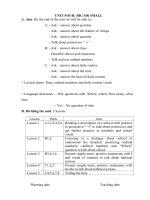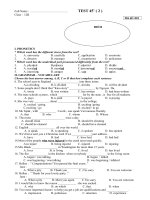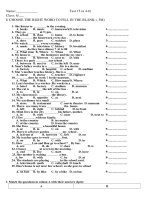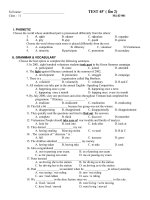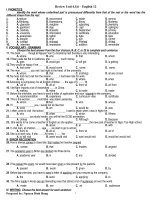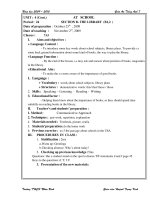Speaking ta11 ilsw unit 4 5 by diên khánh
Bạn đang xem bản rút gọn của tài liệu. Xem và tải ngay bản đầy đủ của tài liệu tại đây (136.38 KB, 7 trang )
TIẾNG ANH 11 I-LEARN SMART WORLD
SPEAKING TOPICS
TOPIC 4: GLOBAL WARMING
1. What is the difference between weather and climate?
Option 1:
The main difference is time. Weather is only temporary. For example, a blizzard can turn into a
flood after just a few warm spring days. Climate, on the other hand, is more than just a few warm or
cool days. Climate describes the typical weather conditions in an entire region for a very long time –
30 years or more.
Option 2:
“Weather” refers to the more local changes in the climate we see around us, on short
timescales from minutes to hours, to days to weeks. Examples are familiar – rain, snow, clouds,
winds, thunderstorms..
“Climate” refers to longer-term averages (which may be regional or global) and can be thought of as
the weather averaged over several decades.
2. What is climate change?
Climate change describes a change in the typical weather for a region — such as high and low
temperatures and amount of rainfall — over a long period of time. Scientists have observed that,
overall, Earth is warming. In fact, many of the warmest years on record have happened in the past
20 years. This rise in global temperature is sometimes called global warming.
3. Is it too late to prevent climate change?
Humans have caused major climate changes to happen already. However, if we stopped emitting
greenhouse gases today, the rise in global temperatures would begin to flatten within a few
years. Temperatures would then plateau but remain well-elevated for many centuries.
4. Do scientists agree on climate change?
Yes, the vast majority of actively publishing climate scientists – 97 percent – agree that humans are
causing global warming and climate change.
5. What’s NASA got to do with climate change?
NASA’s role is to make observations of our Earth's systems (geosphere, biosphere, cryosphere,
hydrosphere, and atmosphere) and how they connect, which can be used by the public, researchers,
policymakers and to support strategic decisions. Its job is to perform rigorous science. However, the
agency does not promote particular climate policies.
6. Is the Sun causing global warming?
No. The Sun can influence Earth’s climate, but it isn’t responsible for the warming trend we’ve seen
in recent decades.
7. What’s the difference between climate change and global warming?
“Global warming” refers to the long-term warming of the planet. “Climate change” encompasses
global warming, but refers to the broader range of changes that are happening to our planet,
including rising sea levels; shrinking mountain glaciers; accelerating ice melt in Greenland,
Antarctica and the Arctic; and shifts in flower/plant blooming times.
1
8. How do we know Earth’s climate is getting warmer?
Scientists have been observing Earth for a long time. They use NASA satellites and other
instruments to collect many types of information about Earth's land, atmosphere, ocean, and ice.
This information tells us that Earth's climate is getting warmer.
9. Why is Earth warming?
Some of the gases in Earth’s atmosphere trap heat from the Sun, like the glass roof and walls of a
greenhouse. These greenhouse gases keep Earth warm enough to live on. Human activities, such as
the destruction of forests and burning fossil fuels, create extra greenhouse gases. This traps are even
more of the Sun’s heat, leading to a warmer Earth.
10. What are the 3 main causes of global warming?
The three main causes of global warming are: burning fossil fuels, deforestation and agricultural
activities.
11. What are 5 ways to stop global warming?
Some of the ways through which we can stop global warming are: driving less, recycling more,
planting trees, replacing regular bulbs with CFL (compact fluorescent light, energy-saving light)
ones, avoiding products with a lot of packaging, etc.
12. How is global warming affecting us?
Climate change affects human health as it depletes the water and air quality, leads to extreme
weather, increases the pace at which certain diseases spread, etc.
Mother Earth is facing the consequences of our careless actions. It is high time now that we should
act and protect the environment. A few decades ago, afforestation, using renewable sources, etc.,
was just an option, but today, these have become a necessity. If we do not change and move towards
a more sustainable growth model, this planet that we all share will be significantly affected, and life,
as we know it today, may perish. Let’s take a pledge to conserve and restore the beauty of our planet
Earth.
13. Do you care about global warming? (Bạn có quan tâm đến sự nóng lên tồn cầu?)
To be honest, I am much aware of this phenomenon since it has been negatively affecting our lives
in many ways. Since high school, I have been taught about how our world would be changed if
global warming happens for a long time.
Thành thật mà nói, tơi nhận thức được nhiều điều về hiện tượng này vì nó đã và đang ảnh hưởng
tiêu cực đến cuộc sống của chúng ta theo nhiều cách. Kể từ khi học trung học, tôi đã được dạy về
việc thế giới của chúng ta sẽ thay đổi như thế nào nếu tình trạng ấm lên tồn cầu xảy ra trong một
thời gian dài.
14. Is this phenomenon affecting your life anyway? (Hiện tượng này có ảnh hưởng gì đến cuộc
sống của bạn không?)
Basically, global warming is really impacting not only my life but also my country. Indeed, as the
overall temperature is rising more and more, summers are hotter than ever, which threatens old
people’s health. Moreover, wildfires are happening more frequently, thereby killing numerous
creatures.
Nói một cách cơ bản là nóng lên tồn cầu thực sự đang ảnh hưởng khơng chỉ đến cuộc sống của tơi
mà cịn cả đất nước của tơi. Thật vậy, khi nhiệt độ trung bình ngày càng tăng cao, mùa hè trở nên
2
nóng hơn bao giờ hết và điều này sẽ đe dọa sức khỏe của người già. Hơn nữa, cháy rừng đang xảy
ra thường xuyên hơn, và do đó giết chết nhiều sinh vật hơn.
15. How did you know about global warming? (Làm thế nào bạn biết về sự nóng lên toàn
cầu?)
If memory serves right, I first got to know this term when I was in secondary school. It was a
geography class when my teacher was talking about this global phenomenon. After that, I also hear
all kinds of information about this on TV and on the internet. And nowadays, this has become a
heated debate on social media platforms and has been concerned by many people.
Tơi nhớ khơng nhầm thì lần đầu tiên tôi biết đến thuật ngữ này là khi tôi cịn học trung học cơ sở.
Đó là một lớp học địa lý khi giáo viên của tơi đang nói về hiện tượng tồn cầu này. Sau đó, tơi cũng
nghe thấy tất cả các thông tin về điều này trên TV và internet. Hiện nay, đây đã trở thành một cuộc
tranh luận sôi nổi trên các nền tảng mạng xã hội và được rất nhiều người quan tâm.
16. Talk about Global Warming:
Describe a disaster that you know about (Mô tả một thảm họa mà bạn biết về)
You should say:
→ What it is (Nó là gì)
→ When this happened (Nó đã xảy ra khi nào)
→ What effects it had on our lives (Những ảnh hưởng của nó lên đời sống của chúng ta)
And why you are concerned about it (Tại sao bạn lại quan ngại về vấn đề này)
In the past few decades, more and more news programs as well as reports have been mentioning one
troublesome global phenomenon called “global warming”.
It is happening right now and is gradually affecting our lives in many ways. According to scientists,
global warming is caused by the greenhouse gases emitted by factories and other human activities.
Year in year out, the overall temperature of the earth has risen to a considerable level, thereby
impacting the existence of all creatures. To be more specific, sea water is now hotter than ever,
therefore, marine beings such as corals or small fish cease to exist. As a result, bigger creatures have
their food sources depleted, so they start dying as well. On top of that, the ice caps are melting,
raising the sea level and then flooding coastal lands. Besides, wildfires are taking place all over the
world, destroying swathes of forests and killing all dwellers inside.
We, humans, are living among nature, and just one tiny change would lead to the destruction of us
all. In recent years, many old people passed away due to the heat in metropolises and there is an
increasing number of diseases happening uncontrollably. Therefore, as a human being, I must be
aware of this phenomenon and try to contribute to mitigating the problem.
Trong vài thập kỷ qua, ngày càng có nhiều chương trình tin tức cũng như báo cáo đề cập đến một
hiện tượng xảy ra trên Trái Đất được gọi là “sự nóng lên tồn cầu”.
Nó đang diễn ra ngay lúc này và đang dần ảnh hưởng đến cuộc sống của chúng ta theo nhiều cách.
Theo các nhà khoa học, hiện tượng trái đất nóng lên là do khí thải ra từ các nhà máy cũng như từ
các hoạt động khác của con người. Từ năm này qua năm khác, nhiệt độ tổng thể của trái đất đã
tăng lên mức đáng kể, do đó tác động đến sự tồn tại của mọi sinh vật. Cụ thể hơn, nước biển hiện
đang nóng hơn bao giờ hết, do đó, các sinh vật biển như san hơ hay cá nhỏ khơng cịn tồn tại được.
3
Kết quả là các sinh vật lớn hơn bị cạn kiệt nguồn thức ăn, vì vậy chúng cũng bắt đầu chết. Trên hết,
các chỏm băng đang tan ra, nâng cao mực nước biển và sau đó gây ngập lụt các vùng đất ven biển.
Bên cạnh đó, cháy rừng đang diễn ra khắp nơi trên thế giới, phá hủy các khu rừng và giết chết tất
cả cư dân bên trong đó.
Chúng ta, con người, đang sống giữa thiên nhiên, và chỉ cần một thay đổi nhỏ cũng sẽ dẫn đến sự
diệt vong của tất cả con người. Trong những năm gần đây, nhiều người già đã qua đời do nắng
nóng ở các đơ thị và ngày càng có nhiều bệnh tật xảy đến mà ta khơng thê kiểm sốt. Vì vậy, là một
con người, ta phải nhận thức được hiện tượng này và cố gắng góp phần giảm thiểu vấn đề đó.
17. What are some effects of global warming? (Một số tác động của sự nóng lên tồn cầu là
gì?)
As far as I’m concerned, this phenomenon has detrimental effects on our world. First and foremost,
it is changing the climate pattern, which means that many areas are now flooded, and tropical
regions are turning into deserts. This caprice has laid waste to a host of habitats and animals living
within. What is more, sea level is rising, evading coastal lands and drowning many livable areas.
Therefore, the territory of many nations has shrunk and agricultural lands along the sea are
disappearing.
Theo như tôi được biết, hiện tượng này có những tác động bất lợi đối với thế giới của chúng ta. Đầu
tiên và cũng là quan trọng nhất, nó đang thay đổi mơ hình khí hậu, có nghĩa là các khu vực hiện
đang bị ngập lụt, và các khu vực nhiệt đới đang biến thành sa mạc. Tính thất thường này đã tạo ra
chất thải cho một loạt các môi trường sống và động vật. Hơn nữa, mực nước biển đang dâng cao,
lấn chiếm các vùng đất ven biển và nhấn chìm nhiều khu vực có thể sống được. Do đó, lãnh thổ của
nhiều quốc gia đã bị thu hẹp và các vùng đất nông nghiệp ven biển cũng đang dần biến mất.
18. What should we do to solve this problem? (Chúng ta phải làm gì để giải quyết vấn đề
này?)
From my personal perspective, it is almost too late to do anything about this. However, there is
something that we can do in order to mitigate the problem. One of the measures is that we limit the
amount of greenhouse gases emitted by factories and human activities. Indeed, not only
manufacturing processes but also transportation is releasing a tremendous amount of gases into the
atmosphere on a daily basis, which must be forced to decrease to a great extent. Another solution to
tackle global warming is to educate young generations on the adverse effects of it on their future, so
that they are likely to develop a sense of responsibility to take care of the world decades later.
Theo quan điểm cá nhân của tôi, hầu như đã quá muộn để làm bất cứ điều gì về nó. Tuy nhiên,
chúng ta có thể làm gì đó để giảm thiểu vấn đề này. Một trong những biện pháp là chúng ta hãy hạn
chế lượng khí nhà kính do các nhà máy và hoạt động từ con người thải ra. Thật vậy, không chỉ các
quy trình sản xuất mà cả giao thơng vận tải cũng đang thải ra một lượng khí khổng lồ vào bầu khí
quyển hàng ngày, lượng khí này buộc phải giảm đến mức lớn. Một giải pháp khác để giải quyết vấn
đề nóng lên tồn cầu là giáo dục các thế hệ trẻ về tác động tiêu cực của nó đối với tương lai của họ,
để họ có thể phát triển ý thức trách nhiệm chăm sóc thế giới trong nhiều thập kỷ sau đó.
4
TOPIC 4: VIETNAM & ASEAN
1.What does ASEAN stand for?
ASEAN stands for Association of South East Asian Nations
2. What Is ASEAN?
It is an intergovernmental organization of ten Southeast Asian countries: Brunei, Cambodia,
Indonesia, Laos, Malaysia, Myanmar, the Philippines, Singapore, Thailand, and Vietnam.
3. How does ASEAN work?
ASEAN is headed by a chair—a position that rotates annually among member states—and is
assisted by a secretariat based in Jakarta, Indonesia.
4.What is the motto of ASEAN?
One vision, one identity, one community is the motto of ASEAN.
5. Which part of Vietnam do you want to live in?
If I were to choose where to live in Vietnam, I would go for Hue – a city in central Vietnam. I have
a bias for Hue because of its historic sites, for its street food, trees and wide boulevard, for the
dessert shop on the esplanade and for the wonderful people I met there. Hue is much less busy than
HCMC or Hanoi, so this guarantees more space for everyone, no matter when you are driving,
bicycling or just walking. You don’t have to worry so much about traffic, you won’t be pushed back
and forth by crowds.
6. What makes you feel proud of your country?
There are a lot of reasons why I feel proud to be a Vietnamese. I love Viet Nam firstly for its food.
Vietnamese food is the best. Vietnamese Pho, Bun cha, Banh cuon, etc. All taste amazing while
being incredibly healthy and cheap. In addition, Viet Nam has many scenic places. Take Ha Noi for
example, while it is the city capital, which is supposed to adopt a crazy busy hectic urban lifestyle,
you can still find quiet and beautiful places in some corners of this city, like The Old Quarters, Hoan
Kiem Lake, Lang Bac, etc.
7. Do you know the history of your country well?
I may know some common knowledge about my country. You know, I am not good at history. In
the past, Vietnam had to beat China to protect our border, Vietnam had to beat France to gain
independence and had to beat America to completely get real independence for the whole country.
8. Do you think your hometown is a good place for a holiday?
Yes, definitely. My hometown is the best place to visit on a holiday as it has the best scenic views
and a lot of places to roam around. Also my hometown, Quy Nhơn, is famous for its delicious food
and stunning beaches.
9. What is the best season to travel in your country?
Personally speaking, the best time to travel in Vietnam is in the span of January to October
10. Would you say your country is a good place for travellers to visit?
Yes, definitely. Vietnam is a favorite destination for many travelers in Southeast Asia, both for the
unique atmosphere and unmistakable difference in culture between the north and south.
5
11.Describe a foreign country you would like to go to. ( A country you have not been to yet)
You should say:
→ what country it is (including where it is in the world)
→ what this country is like
→ what people can do in this country
And explain why you would like to go to this country.
Option 1:
MYANMAR
There are so many countries that I have not had a chance to go to, but one of those that I would like
to visit in my upcoming trip is Myanmar.
It is located in South East Asia. The country is like Thailand 25 years ago, before shopping malls,
and fastfood chains expanded in the country. Thus it remains rustic and traditional compared to the
modern world.
The people here are said to be friendly; they are willing to go out of their way to show
you around and they are very keen on practicing their English skills. Myanmar is famous for its
ancient city named Bagan, with more than 3,000 temples which date back to the 11th century. I
would particulary love to see the Shwedagon Pagoda. It is considered to be the greatest and
most sacred Buddhist temple in the country. The entire structure, which dates back 2,500 years, is
covered with hundreds of gold plates.
Since the country has just been opened up to the outside world, it still keeps the originality of its
culture. That’s why I want to go there, to experience the country and the people
before globalization changes everything.
Option 2:
THAILAND
Bangkok became the world's most visited city in 2013, even beating London, New York, and Paris!
Thailand still reigns as the most popular destination among places to travel in Southeast Asia. A
well-oiled tourism infrastructure makes Thailand one of the easiest places to travel.
With a friendly culture, world-famous food and a good mix of islands, it's easy to see why many
first-time travelers to Southeast Asia begin in Thailand. Plus, Thailand is still relatively inexpensive.
Option 3:
CAMBODIA
Once home to the powerful Khmer empire, Cambodia is still recovering from the effects of
numerous wars. Regardless, locals are among the friendliest you'll encounter in Southeast Asia.
The ancient ruins of Angkor Wat and the surrounding temples are one of the most famous UNESCO
World Heritage Sites in all of Southeast Asia. Millions of visitors travel to Siem Reap to see the
ruins, however, the rest of the country is well worth exploring.
Option 4:
6
MALAYSIA
Travelers to Malaysia get to enjoy Malay, Chinese, and Indian culture (among many others) all in
one place. You'll never run out of tempting food options to try in Kuala Lumpur or Penang, a
world-famous food destination. Opportunities to experience different festivals for many ethnic and
religious groups are plenty.
Malaysia is blessed with excellent roads, trains, and travel infrastructure. Kuala Lumpur is a thriving
capital, and there are plenty of islands for getting away from it all.
Malaysian Borneo, only a cheap flight away, is a romantic, natural paradise with plenty of potential
for adventure.
Option 5:
SINGAPORE
Tiny Singapore is a city, country, and island all at the same time. Despite the size, the nation thrives
and has one of the strongest economies in the world, even boasting the highest number of
millionaires per capita. Singapore is also infamous among budget travelers as being one of the most
expensive destinations to visit in Southeast Asia. Fortunately, eating in Singapore is still
inexpensive.
Like Malaysia, Singapore is an exciting mix of local Malay, Chinese, and Indian influence. The
country is also home to a large number of expats and foreign workers. Unlimited shopping, street
food, impressive museums, and high-rise buildings aren't all. Singapore has plenty of green space
adorned with walking and biking trails to supplement the beautiful waterfront.
Thank you!
7

